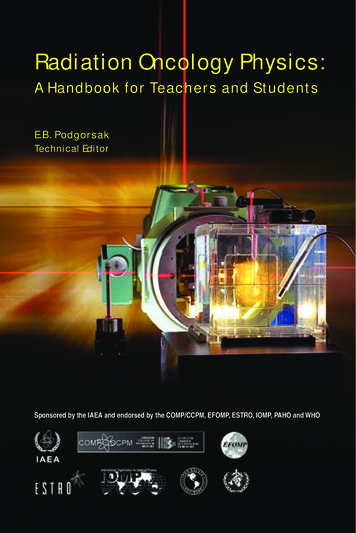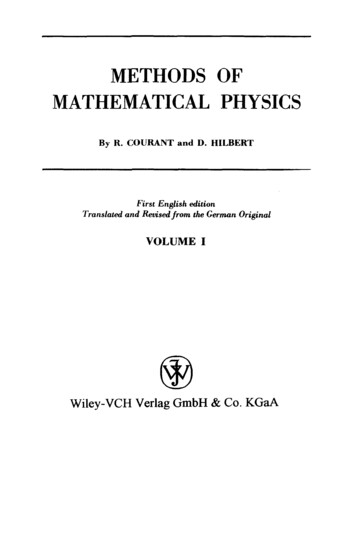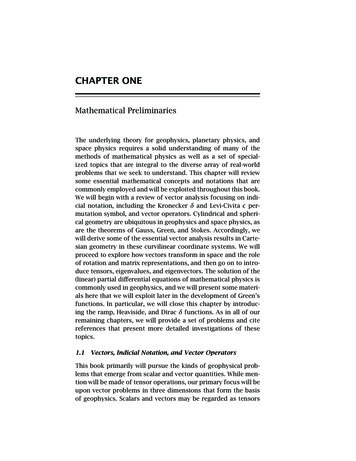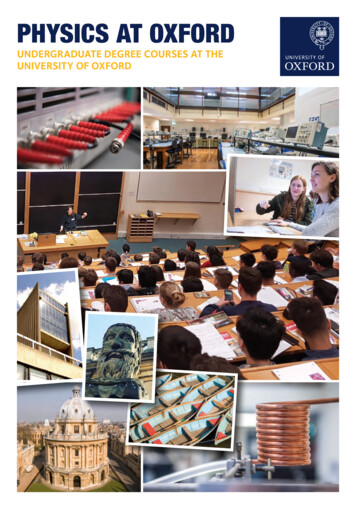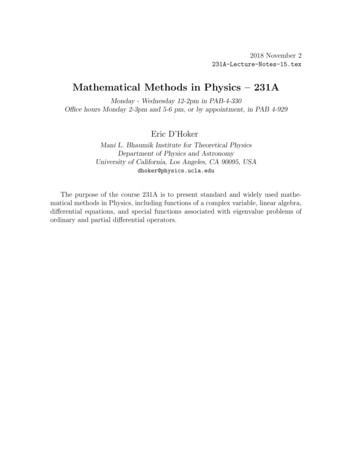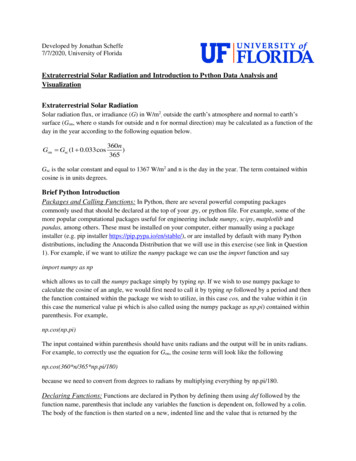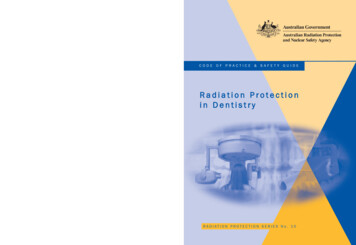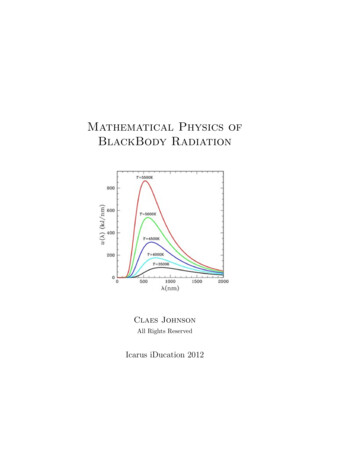
Transcription
Mathematical Physics ofBlackBody RadiationClaes JohnsonAll Rights ReservedIcarus iDucation 2012
2
ContentsIOld Picture31 Blackbody Radiation1.1 Birth of Modern Physics . . . . . . . . . . . . . . . . . . . . .1.2 Planck, Einstein and Schrödinger . . . . . . . . . . . . . . . .1.3 Finite Precision Computation . . . . . . . . . . . . . . . . . .55672 Blackbody as Blackpiano93 Interaction Light-Matter134 Planck-Stefan-Boltzmann Laws4.1 Planck’s Law . . . . . . . . . . . . . .4.2 Stefan-Boltzmann’s Law . . . . . . . .4.3 The Enigma of the Photoelectric Effect4.4 The Enigma of Blackbody Radiation .4.5 Confusion in Media . . . . . . . . . . .4.6 Confessions by Confused Scientists . .4.7 Towards Enigma Resolution . . . . . .1717182324242527.5 Planck/Einstein Tragedy295.1 James Jeans . . . . . . . . . . . . . . . . . . . . . . . . . . . . 295.2 Max Planck . . . . . . . . . . . . . . . . . . . . . . . . . . . . 305.3 Planck and Einstein . . . . . . . . . . . . . . . . . . . . . . . . 326 Classical Derivation of Rayleigh-Jeans Law356.1 Counting Cavity Degrees of Freedom . . . . . . . . . . . . . . 356.2 Dependence of Space Dimension . . . . . . . . . . . . . . . . . 363
4CONTENTS7 Statistics vs Computation377.1 Cut-Off by Statistics . . . . . . . . . . . . . . . . . . . . . . . 377.2 Cut-Off by Finite Precision Computation . . . . . . . . . . . . 37IINew Analysis398 Wave Equation with Radiation418.1 A Basic Radiation Model . . . . . . . . . . . . . . . . . . . . . 419 Spectral Analysis of Radiation9.1 Basic Energy Balance R F . . . . . . . .9.2 Rayleigh-Jeans Law . . . . . . . . . . . . .9.3 Radiation from Near-Resonance . . . . . .9.4 Thermal Equilibrium from Near-Resonance9.5 The Poynting Vector vs f 2 . . . . . . . .45454849495010 Acoustic Near-Resonance10.1 Radiation vs Acoustic Resonance . .10.2 Resonance in String Instrument . . .10.3 Fourier Analysis of Near-Resonance .10.4 Application to Acoustical Resonance10.5 Computational Resonance . . . . . .535353555657.6363646565666667676969707171.11 Model of Blackbody Radiation11.1 Finite Precision Computation . . . . .11.2 Radiation and Heating . . . . . . . . .11.3 Planck as Rayleigh-Jeans with Cut-off11.4 Planck’s Law: R H F . . . . . . .11.5 Connection to Uncertainty Principle . .11.6 Stefan-Boltzmann’s Law . . . . . . . .11.7 Radiative Interaction . . . . . . . . . .11.8 Heat Capacity . . . . . . . . . . . . . .11.9 Radiative Cooling . . . . . . . . . . . .11.10Interaction by Shared Force . . . . . .11.11Generic Nature of Blackbody . . . . .11.12Cut-Off by Residual Stabilization . . .11.13Cordination Length . . . . . . . . . . .
CONTENTS512 Universal Blackbody7312.1 Kirchhoff and Universality . . . . . . . . . . . . . . . . . . . . 7312.2 Blackbody as Cavity with Graphite Walls . . . . . . . . . . . 7513 Model of Universal Blackbody7714 Radiative Heat Transfer7914.1 Stefan-Boltzmann for Two Blackbodies . . . . . . . . . . . . . 7914.2 Non-Physical Two-Way Heat Transfer . . . . . . . . . . . . . . 8015 Greybody vs Blackbody8316 2nd16.116.216.385858686Law of RadiationIrreversible Heating . . . . . . . . . . . . . . . . . . . . . . . .Mystery of 2nd Law . . . . . . . . . . . . . . . . . . . . . . .Stefan-Boltzmann Law as 2nd Law . . . . . . . . . . . . . . .17 Reflection vs Blackbody Absorption/Emission8718 Blackbody as Transformer of Radiation8919 Hot Sun and Cool Earth9119.1 Emission Spectra . . . . . . . . . . . . . . . . . . . . . . . . . 9120 Blackbody Dynamics9320.1 Recollection of Model . . . . . . . . . . . . . . . . . . . . . . . 9320.2 Radiative Interaction of Two Blackbodies . . . . . . . . . . . . 9521 The21.121.221.321.4Photoelectric EffectNobel Prize to Einstein . . .The photoelectric effect I . .Remark on Viscosity ModelsThe Photolelectric Effect II.97979710110122 The Compton Effect10322.1 The Compton Effect I . . . . . . . . . . . . . . . . . . . . . . 10322.2 The Compton Effect II . . . . . . . . . . . . . . . . . . . . . . 103
6CONTENTS
PrefaceThe mystery of blackbody radiation triggered the birth of modern physicsin 1900, when Planck in an “act of despair” invented the idea of a smallestquantum of energy, which Nature assembles according to laws of statisticswith high frequency high energy waves being rare, because they require manyquanta. But Planck viewed quanta to be merely a mathematical trick toresolve a scientific deadlock of classical wave mechanics, a trick without realphysical meaning.Nevertheless, Einstein used a similar idea of “quanta of light” later calledphotons, to come up with a (simple) formula for the photoelectric effect,which gave him the Nobel Prize in 1921; for the formula but not its derivation based on quanta, because Swedish scientists did not believe in any realityof light quanta or light particles. In late years Einstein confessed that neither he believed in light quanta, but the reservations of the inventors wereoverwhelmed by the snowball of quantum mechanics starting to roll in the1920s.Hundred years later blackbody radiation is back at the center of discussion, now as the cornerstone of climate alarmism based on the idea of atmospheric “backradiation” from so-called “greenhouse gases” causing ”globalwarming”. The weakness of this cornerstone is exposed in the book Slayingthe Sky Dragon: Death of the Greenhouse Gas Theory [19] using argumentsfrom this book.The basic idea is to use a classical deterministic continuum wave mechanics combined with a new feature of finite precision computation, whichNature is supposed to use in analog form and which can be modeled by acomputer in digital form. This leads to a form of computational blackbodyradiation with close connections to the computational thermodynamics andthe 2nd Law of thermodynamics developed in the book Computational Thermodynamics [22].1
2CONTENTSStatistical models based on microscopic randomness were introduced inthermodynamics by Boltzmann in order to prove and explain the 2nd Law,which seemed impossible usinng classical deterministic continuum models.Planck used the same ”trick” to avoid the seemingly unavoidable “ultraviolet catastrophe” in classical deterministic continuum wave mechanics ofblackbody radiation. However, it is in principle impossible to directly testthe validity of a model of microscopic randomness, since that would requirein microscopics of microscopics. On the other hand, the effect of finite precision computation (which can be viewed as a testable rudimentary form ofstatistics) can in be determined which makes model verification possible inprinciple.The present book can be read as a more detailed account of my argumentsin [19] related to radiation, but can also be seen as an attempt to resuscitateclassical deterministic continuum mechanics (as opposed to statistical particle mechanics) from the ‘ultraviolet catastrophe” by fusing it with a newconcept of finite precision computation.Stockholm in November 2011Claes Johnson
Part IOld Picture3
Chapter 1Blackbody RadiationAll these fifty years of conscious brooding have brought me no nearerto the answer to the question, “What are light quanta?”. Nowadaysevery Tom, Dick and Harry thinks he knows it, but he is mistaken.(Einstein 1954)You are the only person with whom I am actually willing to cometo terms. Almost all other fellows do not look from the facts to thetheory but from the theory to the facts; they cannot extricate themselves from a once accepted conceptual net, but only flop about init in a grotesque way. (Einstein to Schrödinger about the statistical“Copenhagen interpretation” of quantum mechanics)Would it not be possible to replace the hypothesis of light quantaby another assumption that would also fit the known phenomena?If it is necessary to modify the elements of the theory, would it notbe possible to retain at least the equations for the propagation ofradiation and conceive only the elementary processes of emission andabsorption differently than they have been until now? (Einstein)1.1Birth of Modern PhysicsModern physics in the form of quantum mechanics and relativity theory wasborn in the beginning of the 20th century from an apparent collapse of classical deterministic physics expressing in mathematical terms the rationalityof the Enlightenment and scientific revolution as Euler-Lagrange differential5
6CHAPTER 1. BLACKBODY RADIATIONequations of Calculus, crowned by Maxwell’s equations for electromagneticsformulated in 1865 by the British physicist Clerk Maxwell.The collapse resulted from a couple of scientific paradoxes, which appeared unsolvable using classical physics, both connected to light as electromagnetic waves described by Maxwell’s equations: ultra-violet catastrophy of blackbody radiation: infinite energy, non-existence of an aether as a medium carrying electromagnetic waves.Theoretical science cannot tolerate paradoxes or contradictions, because ina contradictory mathematical theory everything is both true and false at thesame time, and thus a paradox presented by some critics of a theory mustbe handled one way or the other by the proponents of the theory. A paradoxcan be deconstructed by showing that it is only an apparent paradox, not areal paradox, which is the only scientifically acceptable solution.The ultra-violet catastrophegave birth to quantum mechanics and thenon-existence of an aether to relativity theory. Today, hundred years and twoWorld Wars later, modern physics has again reached an impasse describedin David Lindleys The End of Physics: The Myth of a Unified Theory withstring theory as an ultimate expression of a depart from rationality in modernphysics.1.2Planck, Einstein and SchrödingerThe task of resolving the paradox of the ultraviolet catastrophe of blackbodyradiation was taken on by the young ambitious physicist Max Planck in hisrole as scientific leader of the emerging German Empire. After much agonyand battle with his scientific soul, in 1900 Planck came up with a resolutionwhich involved a depart from the concept of light as a deterministic wavephenomenon described by Maxwell’s equations, to a description by statisticsof particles or quanta of energy named photons.Planck thus returned to Newton’s corpuscular theory of light, which hadbeen replaced by Maxwell’s wave theory in the late 19th century, now in acombination with the new particle statistics of thermodynamics developedby Ludwig Boltzmann. In an ”act of despair” Planck gave up deterministiccontinuum physics for statistics of of particles and thus opened the doorto modern physics with wave-particle duality viewed as a resolution of theinescapable contradiction between wave and particle.
1.3. FINITE PRECISION COMPUTATION7Einstein picked up Planck’s quanta as a patent clerk in one of his five articles during his ”annus mirabilis” in 1905, and suggested an explanation of alaw of photoelectricity which had been discovered experimentally. This gavePlanck’s quanta a boost and in 1923 Einstein the Nobel Prize in Physics,not for his explanation based on light as particles, which the Nobel Committee did not buy, but for the ”discovery” of a law which had already beendiscovered experimentally.Both Planck and Einstein introduced discrete quanta of energy as a”mathematical trick” without physical reality in order to avoid the ultraviolet catastrophelong before the quantum mechanics of atoms was formulatedin the 1920s in the form of Schrödinger’s wave equation, even before theexistence of atoms had been experimentally confirmed.Planck, Einstein and Schrödinger refused to embrace the new quantummechanics with the wave function as the solution of the Schrödinger’s waveequation being interpreted as a probability distribution of discrete particles.They were therefore left behind as modern physics took off on a mantra ofwave-particle duality into a new era of atomic physics, with the atomic bombas evidence that the direction was correct.The inventors of quantum mechanics were thus expelled from the newworld they had created, but the question remains today: Is light waves orparticles? What is really wave-particle duality?There is massive evidence that light is waves, well described by Maxwell’sequations. There are some aspects of light connected to the interaction oflight and matter in emission and absorption of light which are viewed to bedifficult to describe as wave mechanics, with blackbody radiation as the basicproblem.If blackbody radiation captured in Planck’s Law of Radiation can bederived by wave mechanics, then a main motivation of particle statisticsdisappears and a return to rational determinism may be possible. And afterall Schrödinger’s equation is a wave equation and Schrödinger firmly believedthat there are no particles, only waves as solutions of his wave equation.1.3Finite Precision ComputationIn this book I present an analysis of blackbody radiation with a new proof ofPlanck’s Law based on a deterministic wave model subject to a certain limitation of finite precision computation which replaces the full particle statistics
8CHAPTER 1. BLACKBODY RADIATIONused by Planck in his original proof. Finite precision computation modelsphysics as an analog computational process with input data being transformed to output data, which can be simulated by digital computation. Theidea of finite precision computation is also used in an alternative theory ofthermodynamics in the form of Computational Thermodynamics [22], without any statistics.I follow up in Many-Minds Quantum Mechanics [3] following the originalidea of Schrödinger to view the Schrödinger wave equation as a model ofinteracting electrons and atomic in the form of a coupled set wave functionswithout any need of statistical interpretation. The idea of many-minds isalso also used in a new approach to relativity [4] without the paradoxes ofEinsteins special theory of relativity.
Chapter 2Blackbody as BlackpianoExperiments on interference made with particle rays have given brilliant proof that the wave character of the phenomena of motion asassumed by the theory does, really, correspond to the facts. The deBroglie-Schrodinger method, which has in a certain sense the character of a field theory, does indeed deduce the existence of only discretestates, in surprising agreement with empirical facts. It does so on thebasis of differential equations applying a kind of resonance argument.(Einstein, 1927)A blackbody is a theoretical idealized object described as something ”absorbing all incident radiation” commonly pictured as a cavity or empty bottle/box in which waves/photons are bouncing back and forth between wallsat a certain temperature defining the temperature of the cavity. The bottlehas a little peephole through which radiation is escaping to be observed, asindicated in the above common illustration of a blackbody.A blackbody is supposed to capture an essential aspect of the radiationfrom a real body like the visible glow from a lump of iron at 1000 C, the Sunat 6000 C or the invisible infrared faint glow of a human body at 37 C.But why is a lump of iron, the Sun or a human body thought of as anempty bottle with a peephole?Yes, you are right: It is because Planck used this image in his proof ofPlanck’s Law of blackbody radiation based on statistics of energy quanta/photonsin a box. Planck’s mathematical proof required a certain set up and that setup came to define the idealized concept of a blackbody as an empty bottlewith peephole. But to actually construct anything near such a blackbody isimpossible.9
10CHAPTER 2. BLACKBODY AS BLACKPIANOIt is natural to ask if with another proof of Planck’s Law, the concept ofblackbody would be different, possibly closer to reality?This book gives a positive answer in a different proof of Planck’s Law witha different concept of blackbody as a lattice of vibrating atoms absorbing andemitting radiation as electromagnetic waves, which models a real body likea lump of iron, and not a fictional empty bottle with a peephole. We shallsee that here is a close acoustical analog of a such a blackbody in terms ofthe strings and soundboard of a grand piano: a blackbody as a blackpiano!This shows the role of mathematics in the formation of concepts of theWorld: With a strange mathematical proof the World may appear strange andincomprehensible. With a natural mathematical proof the World my become comprehensible.Figure 2.1: Blackbody as a cavity filled with photons bouncing back andforth.
11Figure 2.2: Blackbody as strings and soundboard of a grand piano.
12CHAPTER 2. BLACKBODY AS BLACKPIANO
Chapter 3Interaction Light-MatterLight and matter are both single entities, and the apparent dualityarises in the limitations of our language. (Heisenberg)What we observe as material bodies and forces are nothing but shapesand variations in the structure of space. Particles are just schaumkommen (appearances).The world is given to me only once, not one existing and one perceived. Subject and object are only one. The barrierbetween them cannot be said to have broken down as a result of recent experience in the physical sciences, for this barrier does not exist.(Schrödinger)One of the big mysteries of physics is the interaction between immateriallight and material matter, or in a wider context the interaction betweenimmaterial soul/mind and material body.Descartes believed that the interaction soul-body took place in the littlepineal gland in the center of the brain. Modern neurobiology does not givemuch support to Descartes’ idea but has not really any better theory and sothe mystery of how soul and body interact remains to be resolved.What does then modern physics say about the interaction of light andmatter? There are two competing theories depending on the nature of lightas Deterministic electromagnetic waves described by Maxwell’s equations.Statistics of massless particles. 2. connects to Newton’s old corpusculartheory of light, which was revived by Einstein in 1905 after it had beendeclared dead and had been replaced by Maxwell’s wave theory in the late19th century.2. became popular because it offered a resolution to the light-matter interaction problem by simply side-stepping the whole question by claiming13
14CHAPTER 3. INTERACTION LIGHT-MATTERthat everything is (statistics of) particles: If light is not an immaterial electromagnetic wave phenomenon, but simply some sort of material particles(albeit without mass, but never mind) then there is no wave-matter problemto resolve!Clever, but maybe too clever since after all light is an electromagneticwave phenomenon. This brings us back to 1. and the real question of howan immaterial wave can interact with a material body?In Mathematical Physics of Blackbody Radiation I suggest a resolutionwith immaterial waves interacting with matter by wave resonance and statistics replaced by finite precision computation. This is a resolution in termsof waves with electromagnetic wave motion interacting with wave motion inmatter ultimately also consisting of electromagnetic waves.The wave-matter interaction problem is thus in this case resolved byunderstanding that everything is (finite precision) wave and wave resonance,both light and matter. In the wider context: everything is soul and soulresonance.We have thus two possible solutions of the light-matter interaction problem: Everything is (finite precision) deterministic wave and wave resonance. Everything is statistics of particles and collision of particles.Maxwell and Schrdinger said 2. This book says 2.
15Figure 3.1: Interaction of soul and body through the pineal gland accordingto Descartes.
16CHAPTER 3. INTERACTION LIGHT-MATTER
Chapter 4Planck-Stefan-Boltzmann LawsThe spectral density of black body radiation . represents somethingabsolute, and since the search for the absolutes has always appearedto me to be the highest form of research, I applied myself vigorouslyto its solution. (Planck)4.1Planck’s LawThe particle nature of light of frequency ν as a stream of photons of energy hνwith h Planck’s constant, is supposed to be motivated by Einstein’s model ofthe photoelectric effect [6] viewed to be impossible [31] to explain assuminglight is an electromagnetic wave phenomenon satisfying Maxwell’s equations.The idea of light in the form of energy quanta of size hν was introducedby Planck [5] in “an act of despair” to explain the radiation energy Rν (T )emitted by a blackbody as a function of frequency ν and temperature T , perunit frequency, surface area, viewing solid angle and time:Rν (T ) γT ν 2 θ(ν, T ),γ 2k,c2(4.1)with the high-frequency cut-off factorθ(ν, T ) hνkThνe kT 1,(4.2)where c is the speed of light in vacuum, k is Boltzmann’s constant, withhνhνθ(ν, T ) 0 for kT 10 say and θ(ν, T ) 1 for kT 1. Since h/k 10 10 ,17
18CHAPTER 4. PLANCK-STEFAN-BOLTZMANN LAWSthis effectively means that only frequencies ν T 1011 will be emitted, whichfits with the common experience that a black surface heated by the highfrequency light from the Sun, will not itself shine like the Sun, but radiateonly lower frequencies. We refer to kTas the cut-off frequency, in the sensehkTthat frequencies ν h will be radiated subject to strong damping. We seethat the cut-off frequency scales with T , which is Wien’s Displacement Law.In other words, the cut-off distance in terms of wave-length scales with T1 asshown in Fig. 4.1.Below we shall for simplicity leave out the constant of proportionality in(4.1) and write Rν (T ) T ν 2 θ(ν, T ) expressing the dependence on T andν, with denoting proportionality. But it is important to note that theconstant γ 2kis very small: With k 10 23 J/K and c 3 108 m/s, wec2have γ 10 40 . In particular, γν 2 1 if ν 1018 including the ultravioletspectrum, a condition we will meet below.4.2Stefan-Boltzmann’s LawBy integrating/summing over frequencies in Plancks radiation law (4.1), oneobtains Stefan-Boltmann’s Law stating the the total radiated energy R(T )per unit surface area emitted by a black-body is proportional to T 4 :R(T ) σT 4(4.3)2π k 8W 1 m 2 K 4 is Stefan-Boltzmann’s constant.where σ 15c2 h3 5.67 10On the other hand, the classical Rayleigh-Jeans Radiation Law Rν (T ) 2T ν without the cut-off factor, results in an “ultra-violet catastrophy” withinfinite total radiated energy, since nν 1 ν 2 n3 as n .Stefan-Boltzmann’s Law fits (reasonably well) to observation, while theRayleigh-Jeans Law leads to an absurdity and so must somehow be incorrect.The Rayleigh-Jeans Law was derived viewing light as electromagnetic wavesgoverned by Maxwell’s equations, which forced Planck in his “act of despair”to give up the wave model and replace it by statistics of “quanta” viewinglight as a stream of particles or photons. But the scientific cost of abandoningthe wave model is very high, and we now present an alternative way ofavoiding the catastropheby modifying the wave model by finite precisioncomputation, instead of resorting to particle statistics.We shall see that the finite precision computation introduces a highfrequency cut-off in the spirit of the finite precision computational model5 4
4.2. STEFAN-BOLTZMANN’S LAW19Figure 4.1: Radiation Energy vs wave length at different temperatures of aradiating body, per unit frequency. Observe that the cut-off shifts to higherfrequency with higher temperature according to Wien’s Displacement Law
20CHAPTER 4. PLANCK-STEFAN-BOLTZMANN LAWSFigure 4.2: Planck 1900: .the whole procedure was an act of despairbecause a theoretical interpretation had to be found at any price, no matterhow high that might be.
4.2. STEFAN-BOLTZMANN’S LAW21Figure 4.3: Planck to Einstein: I hereby award you the Planck Medal because you expanded my desperate idea of quantum of energy to the even moredesperate idea of quantum of light.Figure 4.4: The photoelectric effect according to Einstein.
22CHAPTER 4. PLANCK-STEFAN-BOLTZMANN LAWSfor thermodynamics presented in [22].The photon is considered to be a ”particle” with no mass and no charge,but to observe individual photons appears to be extremely difficult. In fact,the existence of photons seems to be highly hypothetical with the main purpose of explaining black-body radiation and the photoelectric effect. If explanations of these phenomena may be given using classical wave mechanics,maybe the existence of photons as particles without both mass and chargemay be seriously questioned, including statistical particle mechanics, as Einstein himself did during the later half of his life [16, 10, 11, 12, 14, 18].Figure 4.5: Wien’s Displacement Law.The scientific price of resorting to statistical mechanics is high, as wasclearly recognized by Planck and Einstein, because the basic assumption ofstatistical mechanics of microscopic games of roulette seem both scientificallyillogical and impossible to verify experimentally. Thus statistical mechanicsruns the risk of representing pseudo-science in the sense of Popper [?] becauseof obvious difficulties of testability of basic assumptions.The purpose of this note is to present an alternative to statistics for blackbody radiation based on finite precision compuation in the form of GeneralGalerkin G2. We also extend to include aspects of photo-electricity and theCompton effect.
4.3. THE ENIGMA OF THE PHOTOELECTRIC EFFECT23Figure 4.6: Wilhelm Wien (1864-1928).4.3The Enigma of the Photoelectric EffectThe most convincing evidence of the particle nature of light is supposed tobe that the photoelectric effect has a dependence on the frequency of theincident light, which is not present in a basic linear wave mechanical modelwithout viscosity effects: A electric current of electrons ejected by incidentlight requires the frequency to be larger than a certain threshold, and moroverthe kinetic energy of the ejected electrons scales with the frequency abovethe threshold. Photoelectricity thus has a frequency dependence, which isnot present in a linear wave model with solutions scaling with the intensityof the forcing.But a wave model with a small viscosity acting on derivatives of the state,also exhibits frequency dependence, and can be designed to model basic aspects of photoelectricity. In particular we shall find that G2 finite precisioncomputation introduces a frequency dependent viscosity acting above a certain threshold and thus shares features with photoelectricity. The argumentthat the only particle models are capable of describing photoelectricity thusis weak. Since this is the main argument, it appears that the evidence againstthe particle nature of light suggested by Newton, presented by Young, Fresnel
24CHAPTER 4. PLANCK-STEFAN-BOLTZMANN LAWSand Maxwell in the 19th century, is still strong.4.4The Enigma of Blackbody RadiationThe basic enigma of blackbody radiation can be given different formulations: Why is a blackbody black/invisible, by emitting infrared radiationwhen “illuminated” by light in the visible spectrum? Why is radiative heat transfer between two bodies always directed fromthe warmer body to the colder? Why can high frequency radiation transform to heat energy? Why can heat energy transform to radiation only if the temperature ishigh enough? Why is low-frequency radiative heating inefficient?We shall find that the answer is resonance in a system of resonators (oscillating molecules): incoming radiation is absorbed by resonance, absorbed incoming radiation is emitted as outgoing radiation, or isstored as internal/heat energy, outgoing radiation has a frequency spectrum T ν 2 for ν . T , assuming all frequencies ν have the same temperature T , with a cut-off tozero for ν & T , incoming frequencies below cut-off are emitted, incoming frequencies above cut-off are stored as internal heat energy.4.5Confusion in MediaThe mystery of blackbody radiation opened to the mystery of quantum mechanics permeating modern physics: Einstein vs Niels Bohr
4.6. CONFESSIONS BY CONFUSED SCIENTISTS25 Solvay Conference 1927 Max Planck and Blackbody Radiation 1 Max Planck and Blackbody Radiation 2 Theory of Heat Radiation by Max Planck4.6Confessions by Confused ScientistsTo motivate that a renewed analysis of blackbody radiation is needed, 110years after Planck, we recall some statements of famous scientists indicating what they really think about the quantum mechanics, light quanta andphotons forming the basis of Planck’s description of blackbody radiation (including the introductory quotes by Einstein and Planck’s “act of despair”).If we are going to have to put up with these damned quantum jumps,I am sorry that I ever had anything to do with quantum mechanics.(Schrödinger to Bohr 1926)To derive the Planck radiation law, it is essential that the energy ofthe atom have discrete values and changes discontinuously. (Bohr toSchrödinger 1926).The discussion between Bohr and Schrödinger began at the railwaystation in Copenhagen and was carried out every day from early morning to late night. Bohr appeared to me like a relentless fanatic, whowas not prepared to concede a single point to his interlocutor or toallow him the slightest lack of precision. It will scarely be possible toreproduce how passionate the discussion was carried out from bothsides. (Heisenberg in Der Teil und das Ganze)Niels Bohr brainwashed a whole generation of theorists into thinkingthat the job of interpreting quantum theory was done 50 years ago.(Murray Gell-Mann)It is nonsense to talk about the trajectory
1.1 Birth of Modern Physics Modern physics in the form of quantum mechanics and relativity theory was born in the beginning of the 20th century from an apparent collapse of clas-sical deterministic physics expressing in mathematical terms the rationality of the Enlightenment and scienti c revolution as Euler-Lagrange di erential 5

